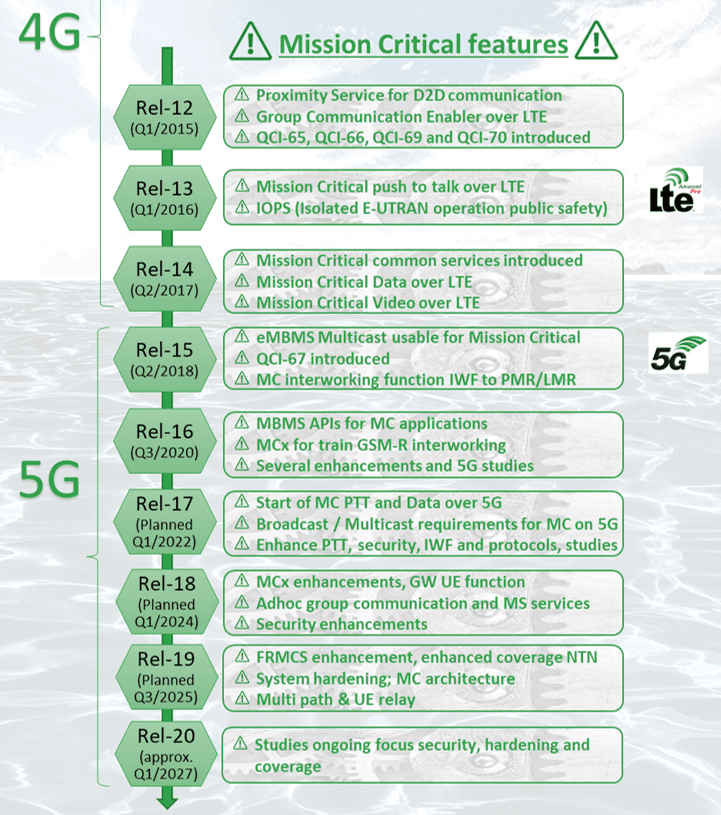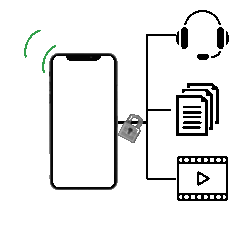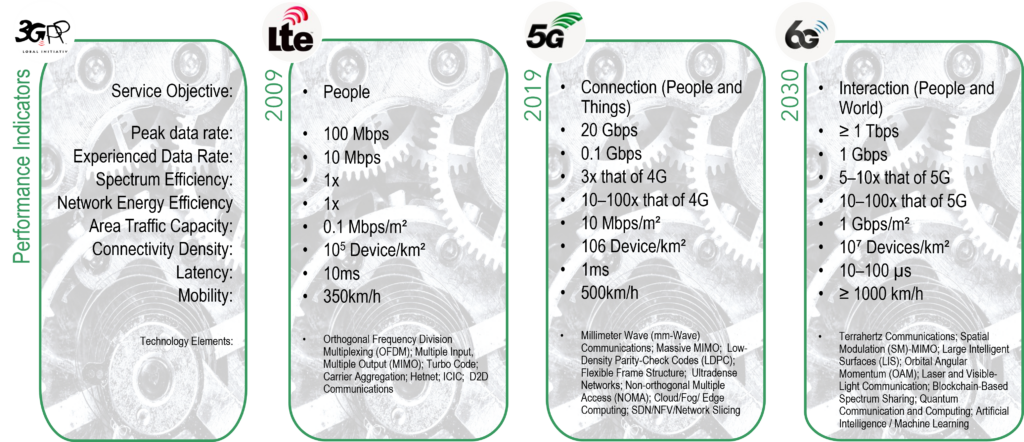5G a new milestone within mobile communication
5G is a new set of releases defined by 3GPP, starting from release 15 the so-called new generation radio (5G) hast started.
5G system can be operated in so called NSA and SA mode. NSA stands for non-stand alone and will thereby use an existing 4G network to access the system, before utilising the highspeed data rate performance of 5G for data transmission. SA stands for stand-alone system and is a 5G system only, access to the system must be performed directly on 5G.
Main marketing benefits of the new 5G standard are:
- 10 times the data rate of 4G ~1000Mbit/s (download peaks even up to 20Gbit/s)
- 10 times device density of 4G ~ 1.000.000/km²
- 10 times less latency than 4G ~ 1ms
Main drivers for the development of 5G has been based on the needs of Internet of Things (IoT) and the Vehicle to anything communication (V2X) for automated driving:
- Operational in licensed and unlicensed spectrum
- Designed for IoT and V2X
MC-Data, MC-Video, Mc-PTT or other MCx services via 4G and 5G

Anyhow, although mission critical communications has not been a design criterion when developing 5G, the technology in in similar and potentially even better ways usable for mission critical communications (MCx) than 4G LTE due to higher bandwidths and lower latencies.
The figure provides an overview of the 3GPP releases 12 to 20 with regards to the mission critical features. 5G if priorities due to a shared network with other users or organisations are required, will be usable for critical communication from release 17 onwards.
MC-PTT, -data and -video are the most common services, specified. They can basically consist of an application server, being inserted into the used infrastructure and client applications, which can run on any PC, laptop, tablet or smartphone. The levels of service supported device types as well as operating systems hereby differ from manufacturer to manufacturer.
So called MCx plug tests organised via TCCA and ETSI do ensure that manufacturers have the chance to test their interoperability with other brands. This is the most important difference between any PoC (PTT over cellular) services and MCx. MCx does support interoperability, is based on a standard and thereby gains different priorities within the network guaranteeing service availability. Currently these plug tests are performed based on market available infrastructure and software of release 15 and 16.

Public or private infrastructure
With the availability of 5G infrastructure especially in the non-licensed spectrum at several GHz private installations for home, IoT and also for mission critical applications will become far more common. The device and infrastructure density is expected to go far beyond 4G and thereby also the costs are expected to get more down after the bleeding edge first movers investments have been made.
The defined quality levels within the 5G infrastructure will allow sharing a network between several using parties and ensuring the data traffic will pass according to order of defined priorities and throughputs. This is not really new, since it already exists within 4G, but will become more important even in private networks, if they are going to replace the Wi-Fi installations and if more IoT services are running on this private network, while still in emergency mission critical communications must have priority to pass the shared air interface.
Private Mobile Networks (MPN) which are also often abbreviated P5G (private 5G) are becomming more and more affordable and spectrum
available.
In Germany they are also called “Campusnetz” or “Campus-Netwzwerk“. Those networks can be deployed in 4G or 5G, using the Band B43 or N78 in 3,7-3,8MHz (infuture also 26GHz). The Bundesnetzagentur makes frequency application and costs very transparent and affordable for any enterprise. Private spectrum for these Campusnetze was started in 2019 in Germany. Many other nations in the meantime offer private spectrum as well.
Backward integration and migration / Interworking Function (IWF)
Integration of 5G networks with TETRA, P25 or other LMR systems will be possible thanks to the ETSI defined IWF (interworking function) on the Mission Critial application server. Also with an NSA setup, devices will still be capable of 4G signal decoding and be able to utilise this infrastructure outside 5G coverage, if required. A consequent, slow and cost saving migration process is hereby ensured, if you keep this in mind, during your component and system choice.
We are pleased to provide you the right advice at the right time in case of uncertainty. This is what we do daily and where we are experts in. No one can focus on everything and if people try, they will loose the level of technical depth. As loyal and independent partner, we will take care of this part, provide educational training
What do we offer?
We are pleased to provide you the right advice at the right time in case of uncertainty. This is what we do daily and where we are experts in. No one can focus on everything and if people try, they will lose the level of technical depth. As loyal and independent partner, we will take care of this part:
- Provide educational training
- Contact network of vendors
- Market screening
- Executive or detailed summaries and presentations
Connected and partner with us, you will find yourself in good hands with industrial experts and can focus on your own business.
3GPP release generation overview

